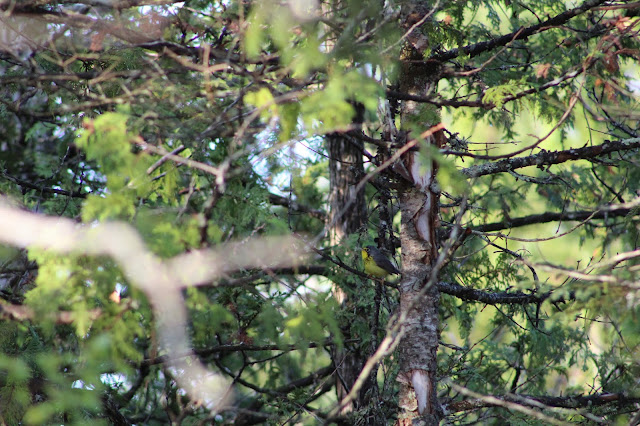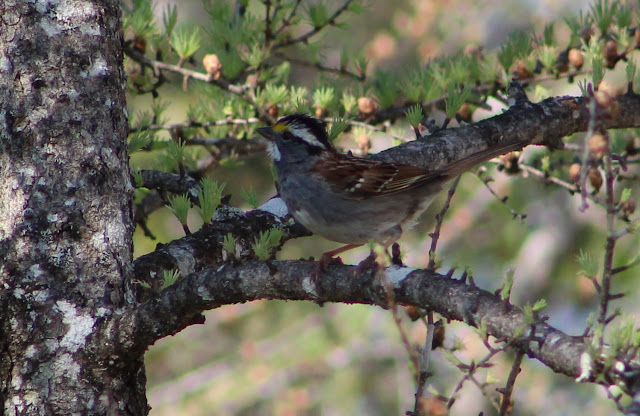The Mackinaw Bridge was a treat to drive over again as I went from the lower to upper peninsula in a matter of minutes via the bridge over the Lake Michigan and Lake Huron divide. Once I got on state highways, I wanted to stop at many different locations as I drove. The scenery was awesome, and seeing roadside birds like Bald Eagles and Sandhill Cranes were good indicators that the birding would be good. I kept myself disciplined to not get carried away and to stop at a bunch of locations before I would get to the main location of the day that I had in mind. The GPS was running for directions, and after passing through state highway for about a minute and entering into Michigan's Chippewa County, I arrived at my main location interest for the day, which was Hulbert Bog.
Highway 28 accessed Basnau Road, which the Basnau Road branched off in a straight direction to the due east, while Highway 28 had ran in a straight, slightly southwestern direction for a good length. It was an interesting intersection. Basnau Road accesses Hulbert Bog just off of Highway 28, and runs to the east for two miles through the bog. As Basnau runs through Hulbert Bog, the road is in good shape and one can park and easily access the bog just about anywhere. I was aware of that, but I decided to park at the Highway 28 and Basnau Road intersection and walk east for two miles on Basnau to explore the bog slowly and to take my time. When I first started, I didn't think it was going to take me as long as it did. A good birding spot is a good birding spot!
In the early going, the songs of Alder Flycatchers came everywhere from a more open area on the west side of the bog. Common Yellowthroats matched their numbers. Upon starting, this male Black-and-white Warbler sang along the edge of the road, and it was awesome when it came down to getting his picture taken!
The exciting department really lit up when I heard calls above me that we coming from White-winged Crossbills. This northern species breeds in the northernmost regions of North America, and will breed in the northern states I was in during years. Prior to my trip, I was seeing regular, but not abundant, reports of White-winged Crossbills, which indicated that this was a year that they were breeding. As I heard them flying over me, they became an official life bird. I looked up to see a flock flying over the bog, and they kept on going. There must have been at least fifteen birds in the flock. I heard their distinctive, dry, and low, "chut-chut" calls and the flock was vocal. Minutes later, a single White-winged Crossbill flew overhead and was lower, and I got to hear it's flight calls more clearly than the flock who had just gone by. I looked up to see the bird visually, but it kept going and avoided my hopes of wanting to see one perched in one of the spruce trees within the bog. When the Crossbills flew over, I took a recording. One can barely make out the White-winged Crossbills, but I did capture some of the early morning bird chorus.
As I went through the bog, this Canada Warbler, as any Canada Warbler, sparked a fun sighting. It was working it's usual tangles of dense habitat and would come into view every now and then.
When walking through a bog during crisp, early morning air, it's a good time to hear a variety of bird songs. While most bird songs are peaceful, some of them have the power to immediately cleanse and refresh the mind. One example of a song like that comes from the Black-throated Green Warbler. It gives a beautiful song.
Looking ahead of me was a Snowshoe Hare. Right now they are brown with white feet, but in winter their fur turns into a solid white.
The next warbler that I photographed was a male Mourning Warbler who sang out in the open for a few minutes.
An awesome American Redstart male!
A big highlight came from watching a pair of Magnolia Warblers forage in dense habitat. The male gave me the chance for photographs, and the female popped up briefly. This was the first time of the trip I encountered Magnolias on their breeding grounds. Another epic warbler out of many.
One of the best songs in North America comes from the White-throated Sparrow. It's song is heavenly. And it's a sharp-looking sparrow! Hulbert Bog had a lot of them singing throughout the length of the hike.
Even though it was partially covered when I photographed it, I like the way the pictures turned out of this striking Canada Warbler. Yeah, I think this warbler is awesome and whenever I hear one sing, I try to make the most of it!
The last bird I photographed in the bog was this female Purple Finch.
I ended up spending close to three hours at Hulbert Bog. I covered about two miles in one way of walking, and I recorded at total of 57 species. The bird diversity at this location was impressive, and my looking at eBird, most people don't hike the entire length of the bog but usually opt to cover shorter distances and usually stay for shorter time duration. I'm glad that I spent the amount of time there that I did and covered the amount of the entire bog that I did. It makes me appreciate what birding underbirded locations, like this, can do. Here is a link to my eBird checklist:
After Hulbert, I made my way west into Schoolcraft County, Michigan and decided that I would make my last birding stop in Michigan an hour long one at a location called Seney National Wildlife Refuge. On my way to the refuge, I had an American Bittern fly low and just over the highway, where it continued into a marshy area. When I got to Seney National Wildlife Refuge, I decided to drive a seven mile loop drive through lakes, marshes, and woodlands. It was a fun spot to explore for about an hour, and I didn't get too serious about birding it thoroughly. Trumpeter Swans were very common.
From Seney, I wanted to start heading back to Spooner. I took a stop to submit all of my eBird checklists after Seney and a few other Michigan incidentals. I was pleased to see that I had reached over 100 species for Michigan, and I ended up with 106 species total for the state in roughly two birding days. From Kirtland's Warblers to the scenic upper peninsula, Michigan is a place I'd love to return to someday. Ahead of me was six more hours of driving to Gretchen's cabin, where a comfortable and homely sleep sounded great. The next day of the trip was planning to see some of Minnesota's boreal forest. An expedition was planned in place, and the biggest target was yet another warbler. That will be the next stop on Northerly Treks!








































No comments:
Post a Comment